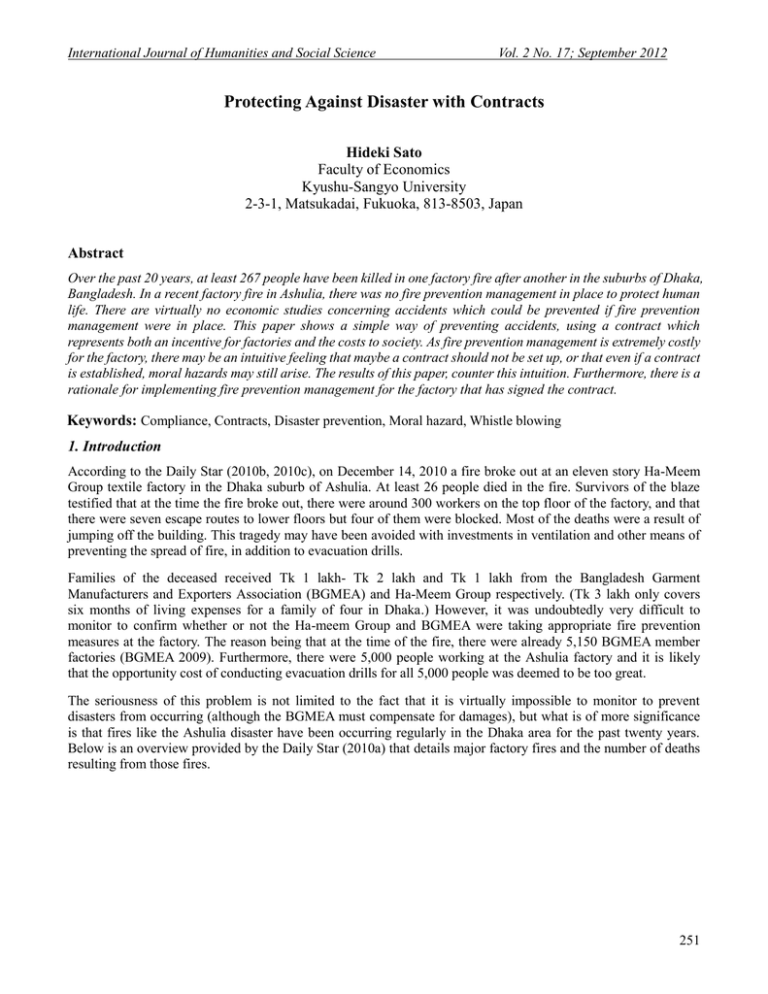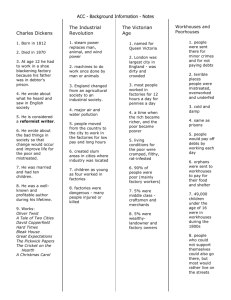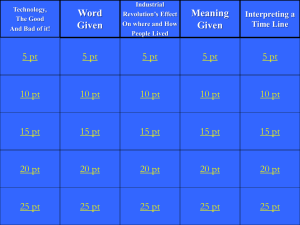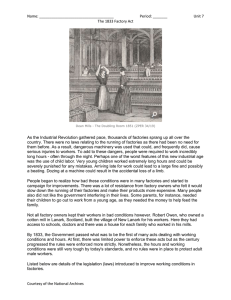Document 10464630
advertisement

International Journal of Humanities and Social Science Vol. 2 No. 17; September 2012 Protecting Against Disaster with Contracts Hideki Sato Faculty of Economics Kyushu-Sangyo University 2-3-1, Matsukadai, Fukuoka, 813-8503, Japan Abstract Over the past 20 years, at least 267 people have been killed in one factory fire after another in the suburbs of Dhaka, Bangladesh. In a recent factory fire in Ashulia, there was no fire prevention management in place to protect human life. There are virtually no economic studies concerning accidents which could be prevented if fire prevention management were in place. This paper shows a simple way of preventing accidents, using a contract which represents both an incentive for factories and the costs to society. As fire prevention management is extremely costly for the factory, there may be an intuitive feeling that maybe a contract should not be set up, or that even if a contract is established, moral hazards may still arise. The results of this paper, counter this intuition. Furthermore, there is a rationale for implementing fire prevention management for the factory that has signed the contract. Keywords: Compliance, Contracts, Disaster prevention, Moral hazard, Whistle blowing 1. Introduction According to the Daily Star (2010b, 2010c), on December 14, 2010 a fire broke out at an eleven story Ha-Meem Group textile factory in the Dhaka suburb of Ashulia. At least 26 people died in the fire. Survivors of the blaze testified that at the time the fire broke out, there were around 300 workers on the top floor of the factory, and that there were seven escape routes to lower floors but four of them were blocked. Most of the deaths were a result of jumping off the building. This tragedy may have been avoided with investments in ventilation and other means of preventing the spread of fire, in addition to evacuation drills. Families of the deceased received Tk 1 lakh- Tk 2 lakh and Tk 1 lakh from the Bangladesh Garment Manufacturers and Exporters Association (BGMEA) and Ha-Meem Group respectively. (Tk 3 lakh only covers six months of living expenses for a family of four in Dhaka.) However, it was undoubtedly very difficult to monitor to confirm whether or not the Ha-meem Group and BGMEA were taking appropriate fire prevention measures at the factory. The reason being that at the time of the fire, there were already 5,150 BGMEA member factories (BGMEA 2009). Furthermore, there were 5,000 people working at the Ashulia factory and it is likely that the opportunity cost of conducting evacuation drills for all 5,000 people was deemed to be too great. The seriousness of this problem is not limited to the fact that it is virtually impossible to monitor to prevent disasters from occurring (although the BGMEA must compensate for damages), but what is of more significance is that fires like the Ashulia disaster have been occurring regularly in the Dhaka area for the past twenty years. Below is an overview provided by the Daily Star (2010a) that details major factory fires and the number of deaths resulting from those fires. 251 © Centre for Promoting Ideas, USA www.ijhssnet.com Table Year 1990 1996 1997 2000 2004 2005 2006 No. of Deaths 32 22 24 20 23 12 23 23 62 Factory Saraka Garments, Dhaka Lusaka Garments, Dhaka Shanghai Apparels, Dhaka Jahanara Fashion, Narayanganj Macro Sweater, Dhaka Globe Knitting, Dhaka Chowdhury Knitwear, Narsingdi Shan Knitting, Narayanganj KTS Garments, Chittagong Source: The Daily Star (2010a) According to the coverage noted above, with globalization the readymade garment industry helped drive Bangladesh's economic growth, and from 1990, over a 16-year period at least 241 people lost their lives in factory fires. And on top of this, another 26 lives were lost in Ashulia due to the simple fact that there were not enough exit routes. There is almost no economic research on preventing disasters such as these. Akhter, Salahuddin, Iqbal, Malek,and Jahan(2010) have provided some valuable research, but it goes no further than touching on fire issues from the perspective of female laborers. In examining things from an economics perspective while looking at the repeated fires that have occurred in the Dhaka area, we see that the risk involved with these disasters can be simply described as an issue of moral hazard. Based on microeconomic theory, this paper presents an optimal contract for factories to voluntarily introduce costly fire prevention measures as a method of disaster prevention. 2. Fire contingency plans and contracts Let us consider the relationship between BGMEA and one of its member factories. BGEMA must provide compensation in the event of loss in a fire and therefore there should be a device in place to limit factory losses as much as possible. From here onward this device will be referred to as "fire contingency plans". However, fire contingency plans can only be made possible by sacrificing production resources. Thus, the opportunity cost for fire contingency plans will be written as: c0. Carrying out fire contingency plans: c>0, and not carrying them out: c=0. Because there are too many BGMEA members it is not possible to monitor to make sure that fire contingency plans are being implemented at factories. This paper posits that the bigger c gets (for example, stopping production lines to conduct drills, construction of fire prevention controls or inspections of escape routes) the probability of a fire breaking out, θ, is reduced. Hereafter, to simplify, the relationship between c and θ has be written as θ=1/(c+1). When it is common knowledge that the BGMEA cannot directly monitor c, factories may attempt to avoid covering costs. The following section presents a method of solving this kind of moral hazard through contracts rather than monitoring. 3. Contracts and whistle-blowing The BGMEA lays out (s,f) in their contract with factories. Here, s is defined as the compensation that the BGMEA must pay factories, employees and their families in the event of a fire. Under this contract, regardless of the size of the fire, factories will be compensated by the BGMEA for losses. However, f is the fine that is imposed on factories by the BGMEA if it is learned that the cause of a fire is due to not implementing fire contingency plans. Therefore this contract takes the "carrot and stick" approach. The BGMEA cannot directly monitor whether or not a fire contingency plan was actually carried out, but it can be determined after the fact through internal whistleblowers. The probability of whistle-blowing, p, is exogenously determined. 252 International Journal of Humanities and Social Science Vol. 2 No. 17; September 2012 The scale of accidents is divided into two types, small: h, and a disaster: H(>h). As stated above, it is not possible to directly monitor whether or not a fire contingency plan was implemented. However, regardless of the scale of the fire, it is possible to indirectly determine if plans were implemented. BGMEA can monitor both H and h. When h has been observed, it is possible to know whether a contingency plan had been implemented or not. But in the case of H, without a whistleblower it is not possible to establish whether the cause was non-implementation of a contingency plan. 4. Designing an optimal contract Within this framework, profit lost by factories due to fire contingency plans as well as losses due to fires (h or H) are referred to as "social costs". Based on this, an optimal contract was designed. If factories implement fire contingency plans, in other words sacrificing only c>0 profits, then accidents will be avoided with a probability of 1-θ(c) and h occurs with a probability of θ(c). If the BGMEA enters into an agreement with a factory in advance, the factory is compensated for only s. In this case, factories can expect costs of c-θ(c)s. The expected value for social costs is c+θ(c)h. Expected factory costs are in step with social costs and compensation is s*=-h. If factories fail to implement fire contingency plans and there is a fire, there is certainty that a major disaster H could occur. In this case, factories will only be compensated s at a probability of 1-p, but if it is learned through a whistleblower that that fire contingency plans were not implemented then factories only have to pay f at a probability of p. Consequently, the factory's expected costs are pf-s. However, since social costs are H, if we consider s*=-h, then the we have f*=(H-h)/p as the fine, which are the social costs in line with the factory's expected costs. Hence, the contract that the BGMEA provides factories is (s*,f*)=(-h,(H-h)/p). Hereafter this is referred to as the optimal contract. Next we will examine whether there are incentives for factories to sign the optimal contract. Under the optimal contract, when fire contingency plans are implemented, factories face expected costs of c-θ(c)s*=c+h/(c+1). And when factories do not implement contingency plans this is pf*-s*=p((H-h)/p+h=H. The difference in expected costs is expressed as ΔC=c+h/(1+c)-H, and when c is large enough (i.e., c>k,k = ((-(1-H)+((1-H)2+4(H-h))1/2)/2), is ΔC>0, and therefore there is incentive for factories to sign into the optimal contract. Consequently, factories will voluntarily sign the optimal contract provided by the BGMEA and implement costly fire contingency plans, meaning that disasters are prevented. The results of this analysis are summarized in the proposition below. Proposition: Under the optimal contract (s*,f*)=(-h,(H-h)/p), both parties reach a consent and disasters can be prevented. 5. Concluding remark If implementing fire contingency plans is extremely costly for factories, they will either be instinctively averse to signing a related contract or fear for moral hazard if they do. The conclusions in this paper are intended to combat that aversion. For factories that sign the contract, there are valid reasons to implement fire contingency plans considering that there is a monotonic decrease with θ in regard to the voluntary c≧0, and the probability that a fire will occur decreases. References S.Akhter, A.F.M. Salahuddin, M. Iqbal, A.B.M.A. Malek,& Jahan,N.(2010). Health and occupational safety for female workforce of garment industries in Bangladesh. Journal of Mechanical Engineering, 41,65-70. BGMEA. (2009).BGMEA at a glance. http://www.bgmea.com.bd/home/pages/aboutus (accessed February 1, 2012) The Daily Star. (2010a). Major RMG fires since ’90. February 27,http://www.thedailystar.net/newDesign/latest_news.php?nid=27425( accessed February 1, 2012) The Daily Star, (2010b). 23 killed in Ha-Meem factory fire, December 14, http://www.thedailystar.net/newDesign/latest_news.php?nid=27425( accessed February 1, 2012) The Daily Star (2010c). “26 killed in factory fire”, December 15,http://www.thedailystar.net/newDesign/news-details.php?nid=166145( accessed February 1, 2012) 253



